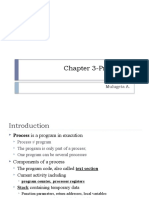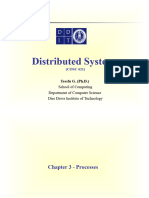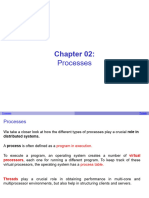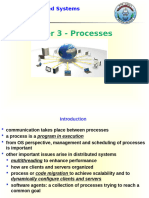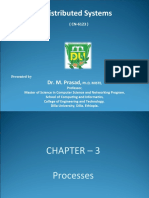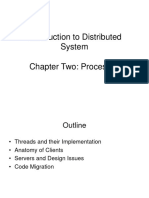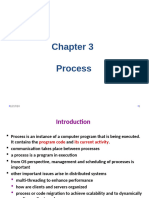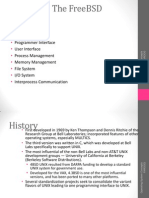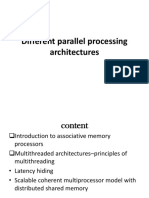3 Processes: 3.1 Threads
3 Processes: 3.1 Threads
Uploaded by
Fyruz FyFiveCopyright:
Available Formats
3 Processes: 3.1 Threads
3 Processes: 3.1 Threads
Uploaded by
Fyruz FyFiveOriginal Description:
Original Title
Copyright
Available Formats
Share this document
Did you find this document useful?
Is this content inappropriate?
Copyright:
Available Formats
3 Processes: 3.1 Threads
3 Processes: 3.1 Threads
Uploaded by
Fyruz FyFiveCopyright:
Available Formats
CA464: D ISTRIBUTED P ROGRAMMING
3
3.1
Processes
Threads
Introduction to Threads
Basic idea We build virtual processors in software, on top of physical processors: Processor: Provides a set of instructions along with the capability of automatically executing a series of those instructions. Thread: A minimal software processor in whose context a series of instructions can be executed. Saving a thread context implies stopping the current execution and saving all the data needed to continue the execution at a later stage. Process: A software processor in whose context one or more threads may be executed. Executing a thread, means executing a series of instructions in the context of that thread.
Context Switching Contexts Processor context: The minimal collection of values stored in the registers of a processor used for the execution of a series of instructions (e.g., stack pointer, addressing registers, program counter). Thread context: The minimal collection of values stored in registers and memory, used for the execution of a series of instructions (i.e., processor context, state). Process context: The minimal collection of values stored in registers and memory, used for the execution of a thread (i.e., thread context, but now also at least MMU register values).
Context Switching Observations 1. Threads share the same address space. Thread context switching can be done entirely independent of the operating system. 2. Process switching is generally more expensive as it involves getting the OS in the loop, i.e., trapping to the kernel. 3. Creating and destroying threads is much cheaper than doing so for processes.
Geoff Hamilton
CA464: D ISTRIBUTED P ROGRAMMING
Threads and Operating Systems
Main issue Should an OS kernel provide threads, or should they be implemented as user-level packages? User-space solution All operations can be completely handled within a single process implementations can be extremely efcient. All services provided by the kernel are done on behalf of the process in which a thread resides if the kernel decides to block a thread, the entire process will be blocked. Threads are used when there are lots of external events: threads block on a per-event basis if the kernel cant distinguish threads, how can it support signaling events to them?
Threads and Operating Systems
Kernel solution The whole idea is to have the kernel contain the implementation of a thread package. This means that all operations return as system calls Operations that block a thread are no longer a problem: the kernel schedules another available thread within the same process. Handling external events is simple: the kernel (which catches all events) schedules the thread associated with the event. The big problem is the loss of efciency due to the fact that each thread operation requires a trap to the kernel. Conclusion Try to mix user-level and kernel-level threads into a single concept.
Solaris Threads Basic idea Introduce a two-level threading approach: lightweight processes that can execute user-level threads.
Thread state User space Thread
Lightweight process Kernel space LWP executing a thread
Geoff Hamilton
CA464: D ISTRIBUTED P ROGRAMMING
Solaris Threads
Principal operation User-level thread does system call the LWP that is executing that thread, blocks. The thread remains bound to the LWP. The kernel can schedule another LWP having a runnable thread bound to it. Note: this thread can switch to any other runnable thread currently in user space. A thread calls a blocking user-level operation do context switch to a runnable thread, (then bound to the same LWP). When there are no threads to schedule, an LWP may remain idle, and may even be removed (destroyed) by the kernel. Note This concept has been virtually abandoned its just either user-level or kernel-level threads.
Threads and Distributed Systems
Multithreaded Web client Hiding network latencies: Web browser scans an incoming HTML page, and nds that more les need to be fetched. Each le is fetched by a separate thread, each doing a (blocking) HTTP request. As les come in, the browser displays them. Multiple request-response calls to other machines (RPC) A client does several calls at the same time, each one by a different thread. It then waits until all results have been returned. Note: if calls are to different servers, we may have a linear speed-up.
Threads and Distributed Systems
Improve performance Starting a thread is much cheaper than starting a new process. Having a single-threaded server prohibits simple scale-up to a multiprocessor system. As with clients: hide network latency by reacting to next request while previous one is being replied. Better structure Most servers have high I/O demands. Using simple, well-understood blocking calls simplies the overall structure. Multithreaded programs tend to be smaller and easier to understand due to simplied ow of control.
Geoff Hamilton
CA464: D ISTRIBUTED P ROGRAMMING
3.2
Virtualizaton
Virtualization Observation Virtualization is becoming increasingly important: Hardware changes faster than software Ease of portability and code migration Isolation of failing or attacked components
Program Interface A Program Interface A Hardware/software system A (a) Implementation of mimicking A on B Interface B Hardware/software system B (b)
Architecture of VMs Observation Virtualization can take place at very different levels, strongly depending on the interfaces as offered by various systems components:
Library functions System calls Privileged instructions
Application Library Operating system Hardware
General instructions
Process VMs versus VM Monitors
Geoff Hamilton
CA464: D ISTRIBUTED P ROGRAMMING
Application Runtime system Runtime system Runtime system Operating system Hardware (a)
Applications Operating system Operating system Operating system Virtual machine monitor Hardware (b)
Process VM: A program is compiled to intermediate (portable) code, which is then executed by a runtime system (Example: Java VM). VM Monitor: A separate software layer mimics the instruction set of hardware a complete operating system and its applications can be supported (Example: VMware, VirtualBox). VM Monitors on operating systems Practice Were seeing VMMs run on top of existing operating systems. Perform binary translation: while executing an application or operating system, translate instructions to that of the underlying machine. Distinguish sensitive instructions: traps to the orginal kernel (think of system calls, or privileged instructions). Sensitive instructions are replaced with calls to the VMM.
3.3
Clients
Clients: User Interfaces Essence A major part of client-side software is focused on (graphical) user interfaces.
Application server Window manager Xlib Local OS Application server Application Xlib interface User's terminal
Xlib Local OS X protocol X kernel Device drivers Terminal (includes display keyboard, mouse, etc.)
Geoff Hamilton
CA464: D ISTRIBUTED P ROGRAMMING
Clients: User Interfaces Compound documents User interface is application-aware interapplication communication: drag-and-drop: move objects across the screen to invoke interaction with other applications in-place editing: integrate several applications at user-interface level (word processing + drawing facilities)
Client-Side Software
Generally tailored for distribution transparency access transparency: client-side stubs for RPCs location/migration transparency: let client-side software keep track of actual location replication transparency: multiple invocations handled by client stub:
Client machine Client appl. Server 1 Server appl Server 2 Server appl Server 3 Server appl
Client side handles request replication
Replicated request
failure transparency: can often be placed only at client (were trying to mask server and communication failures).
3.4
Servers
Servers: General organization Basic model A server is a process that waits for incoming service requests at a specic transport address. In practice, there is a one-to-one mapping between a port and a service.
ftp-data ftp telnet smtp login sunrpc courier 20 21 23 24 25 49 111 530 File Transfer [Default Data] File Transfer [Control] Telnet any private mail system Simple Mail Transfer Login Host Protocol SUN RPC (portmapper) Xerox RPC
Geoff Hamilton
CA464: D ISTRIBUTED P ROGRAMMING
Servers: General organization Type of servers Superservers: Servers that listen to several ports, i.e., provide several independent services. In practice, when a service request comes in, they start a subprocess to handle the request (UNIX inetd) Iterative vs. concurrent servers: Iterative servers can handle only one client at a time, in contrast to concurrent servers
Out-of-band communication
Issue Is it possible to interrupt a server once it has accepted (or is in the process of accepting) a service request? Solution 1 Use a separate port for urgent data: Server has a separate thread/process for urgent messages Urgent message comes in associated request is put on hold Note: we require OS supports priority-based scheduling Solution 2 Use out-of-band communication facilities of the transport layer: Example: TCP allows for urgent messages in same connection Urgent messages can be caught using OS signaling techniques
Servers and state
Stateless servers Never keep accurate information about the status of a client after having handled a request: Dont record whether a le has been opened (simply close it again after access) Dont promise to invalidate a clients cache Dont keep track of your clients Consequences Clients and servers are completely independent State inconsistencies due to client or server crashes are reduced Possible loss of performance because, e.g., a server cannot anticipate client behavior (think of prefetching le blocks)
Servers and state Question Does connection-oriented communication t into a stateless design? Geoff Hamilton
CA464: D ISTRIBUTED P ROGRAMMING
Servers and state Stateful servers Keeps track of the status of its clients: Record that a le has been opened, so that prefetching can be done Knows which data a client has cached, and allows clients to keep local copies of shared data Observation The performance of stateful servers can be extremely high, provided clients are allowed to keep local copies. As it turns out, reliability is not a major problem. Server clusters: three different tiers
Logical switch (possibly multiple) Application/compute servers Distributed file/database system
Client requests
Dispatched request
First tier
Second tier
Third tier
Crucial element The rst tier is generally responsible for passing requests to an appropriate server. Request Handling Observation Having the rst tier handle all communication from/to the cluster may lead to a bottleneck. Solution Various, but one popular one is TCP-handoff
Logically a single TCP connection
Response
Server
Client
Request
Switch
Request (handed off)
Server
Geoff Hamilton
CA464: D ISTRIBUTED P ROGRAMMING
Example: PlanetLab Essence Different organizations contribute machines, which they subsequently share for various experiments. Problem We need to ensure that different distributed applications do not get into each others way virtualization Example: PlanetLab
User-assigned virtual machines Priviliged management virtual machines
Vserver: Independent and protected environment with its own libraries, server versions, and so on. Distributed applications are assigned a collection of vservers distributed across multiple machines (slice).
Process
Process
Process
Process
Process
Process
Process
Process
Process
Process
...
...
...
...
...
Vserver
Vserver
Vserver
Vserver
Vserver
Linux enhanced operating system Hardware
3.5
Code Migration
Code Migration Approaches to code migration Migration and local resources Migration in heterogeneous systems Code Migration: Some Context
Geoff Hamilton
CA464: D ISTRIBUTED P ROGRAMMING
10
Client
Before execution Server
After execution Client Server
code CS state resource
code state* resource
code REV state resource
code state* resource
code CoD state resource
code state* resource
code MA state resource resource resource
code state* resource
Strong and weak mobility Object components Code segment: contains the actual code Data segment: contains the state Execution state: contains context of thread executing the objects code Strong and weak mobility Weak mobility Move only code and data segment (and reboot execution): Relatively simple, especially if code is portable Distinguish code shipping (push) from code fetching (pull) Strong mobility Move component, including execution state Migration: move entire object from one machine to the other Cloning: start a clone, and set it in the same execution state. Managing local resources Problem An object uses local resources that may or may not be available at the target site. Resource types Geoff Hamilton
CA464: D ISTRIBUTED P ROGRAMMING
11
Fixed: the resource cannot be migrated, such as local hardware Fastened: the resource can, in principle, be migrated but only at high cost Unattached: the resource can easily be moved along with the object (e.g. a cache)
Managing local resources Object-to-resource binding By identier: the object requires a specic instance of a resource (e.g. a specic database) By value: the object requires the value of a resource (e.g. the set of cache entries) By type: the object requires that only a type of resource is available (e.g. a color monitor)
Managing Local Resources (2/2)
Unattached ID Value Type MV (or GR) CP (or MV, GR) RB (or MV, GR) Fastened GR (or MV) GR (or CP) RB (or GR, CP) Fixed GR GR RB (or GR)
GR = Establish global systemwide reference MV = Move the resource CP = Copy the value of the resource RB = Re-bind to a locally available resource
Migration in heterogenous systems Main problem The target machine may not be suitable to execute the migrated code The denition of process/thread/processor context is highly dependent on local hardware, operating system and runtime system Only solution Make use of an abstract machine that is implemented on different platforms: Interpreted languages, effectively having their own VM Virtual VM (as discussed previously)
Geoff Hamilton
You might also like
- Processes: Hongfei Yan School of EECS, Peking University 3/15/2010Document69 pagesProcesses: Hongfei Yan School of EECS, Peking University 3/15/2010gaigoleb2No ratings yet
- Processes: Hongfei Yan School of EECS, Peking University 3/16/2011Document69 pagesProcesses: Hongfei Yan School of EECS, Peking University 3/16/2011pbjoshiNo ratings yet
- Chapter-2 Processes and Threads in DSDocument54 pagesChapter-2 Processes and Threads in DSGUTAMA KUSSE GELEGLONo ratings yet
- Chapter 3Document31 pagesChapter 3abdulbaset alselwiNo ratings yet
- ds3 ProDocument72 pagesds3 Prokmd198806No ratings yet
- Chapter 3-Processes: Mulugeta ADocument34 pagesChapter 3-Processes: Mulugeta Amerhatsidik melkeNo ratings yet
- Chapter 3 ProcessesDocument42 pagesChapter 3 ProcessesLusi ሉሲNo ratings yet
- OS Unit - IIDocument74 pagesOS Unit - IIDee ShanNo ratings yet
- Chapter 3, ProcessDocument24 pagesChapter 3, ProcessyonasNo ratings yet
- Threads Revisited: Lecture NotesDocument8 pagesThreads Revisited: Lecture NotesTESFAHUNNo ratings yet
- Chapter 3-ProcessesDocument40 pagesChapter 3-Processesezra berhanuNo ratings yet
- Chapter 2Document30 pagesChapter 2eyob abelNo ratings yet
- Chapter 3-ProcessesDocument40 pagesChapter 3-Processesbirhanualemayehu185No ratings yet
- DS Chapter 3Document39 pagesDS Chapter 3Maddula PrasadNo ratings yet
- Intro To DS Chapter 2Document29 pagesIntro To DS Chapter 2Habib MuhammedNo ratings yet
- Distributed Systems Chapter 3-ProcessesDocument33 pagesDistributed Systems Chapter 3-ProcessesTolosa TafeseNo ratings yet
- 3b - DC Unit 3 Part BDocument36 pages3b - DC Unit 3 Part BShobhit ShahNo ratings yet
- chapter 4Document18 pageschapter 4advaithacharya2000No ratings yet
- NSK OS I 13 Solution 1Document7 pagesNSK OS I 13 Solution 1kotreshisnNo ratings yet
- Chapter 3-Processes2 (1) (1)Document33 pagesChapter 3-Processes2 (1) (1)mtaddis19No ratings yet
- Chapter 2 PDFDocument83 pagesChapter 2 PDFMebratu AsratNo ratings yet
- Linux TutorialDocument10 pagesLinux TutorialRadwa EhabNo ratings yet
- Basic Concept of NetworkingDocument30 pagesBasic Concept of NetworkingtikowanaasuNo ratings yet
- Chapter 3 Processes2Document33 pagesChapter 3 Processes2Awins OumerNo ratings yet
- 4 ThreadsDocument37 pages4 ThreadsAditi VermaNo ratings yet
- History Design Principles Programmer Interface User Interface Process Management Memory Management File System I/O System Interprocess CommunicationDocument62 pagesHistory Design Principles Programmer Interface User Interface Process Management Memory Management File System I/O System Interprocess CommunicationFarooq ShadNo ratings yet
- Chapter 3 - ProcessDocument30 pagesChapter 3 - ProcesslaliselamatoleraNo ratings yet
- Chapter 4Document45 pagesChapter 4bu.patil25No ratings yet
- Chap-3 - ProcessDocument32 pagesChap-3 - ProcessTofik mohammedNo ratings yet
- Lect 4Document48 pagesLect 4Dev MohamdNo ratings yet
- Lecture ThreadDocument45 pagesLecture ThreadMohamad YassineNo ratings yet
- ACA Unit 4Document41 pagesACA Unit 4sushil@irdNo ratings yet
- OsII NotesDocument124 pagesOsII NotesSarathNo ratings yet
- Ch-4 - Threads and ConcurencyDocument35 pagesCh-4 - Threads and ConcurencysankarkvdcNo ratings yet
- Solution JUNEJULY 2018Document15 pagesSolution JUNEJULY 2018Yasha DhiguNo ratings yet
- Multithreads Lecture 3Document29 pagesMultithreads Lecture 3AfrahNo ratings yet
- Event CounterDocument102 pagesEvent CounterAshutosh DashNo ratings yet
- Lab 1 - Osg202 - He194011Document6 pagesLab 1 - Osg202 - He194011Minh Tâm LêNo ratings yet
- The Kernel AbstractionDocument50 pagesThe Kernel AbstractionmosesNo ratings yet
- Device DriversDocument46 pagesDevice DriversAsad ButtNo ratings yet
- CH 03Document34 pagesCH 03Sundar PolosNo ratings yet
- ProcessDocument33 pagesProcessSrijan singhNo ratings yet
- OS 5.threadsDocument43 pagesOS 5.threadsAfza FatimaNo ratings yet
- Slides 03Document22 pagesSlides 03Nauseeta LalNo ratings yet
- OS Multi-Threading ConceptsDocument25 pagesOS Multi-Threading Conceptsbtsarmyforeversince2020No ratings yet
- Threads Part 2Document34 pagesThreads Part 2Ayush NagarNo ratings yet
- Threads and Its Types in Operating SystemDocument8 pagesThreads and Its Types in Operating Systemallisonanna916No ratings yet
- Different Parallel Processing ArchitectureDocument41 pagesDifferent Parallel Processing Architecturesanzog raiNo ratings yet
- Chapter#03 - Threads & Multithreading ConceptDocument32 pagesChapter#03 - Threads & Multithreading ConceptManzar AliNo ratings yet
- Institution of Technology School of Computing Department of Information TechnologyDocument42 pagesInstitution of Technology School of Computing Department of Information TechnologysemagnNo ratings yet
- 4 Threads and ConcurrencyDocument62 pages4 Threads and ConcurrencyMahnoor IjazNo ratings yet
- CH 5. Transaction Processing Monitors: An OverviewDocument59 pagesCH 5. Transaction Processing Monitors: An OverviewJoan J MaiyoNo ratings yet
- COMP3231 80questionsDocument16 pagesCOMP3231 80questionsGenc GashiNo ratings yet
- OS Module 1 Slides-2Document47 pagesOS Module 1 Slides-2yagamilightryuk88No ratings yet
- Chapter 4Document25 pagesChapter 4aashita.ad22No ratings yet
- Unit2 (Os) R20Document52 pagesUnit2 (Os) R20necn cse-b 2nd-yearNo ratings yet
- Introduction To Networking and RMIDocument67 pagesIntroduction To Networking and RMIrina mahureNo ratings yet
- UNIT-V (2 Marks) 1. What Is Amoeba?Document10 pagesUNIT-V (2 Marks) 1. What Is Amoeba?Shanmuga SundaramNo ratings yet
- Science - BSC Computer Science - Semester 5 - 2022 - November - Elective I Linux Server Administration CbcsDocument28 pagesScience - BSC Computer Science - Semester 5 - 2022 - November - Elective I Linux Server Administration CbcsmontysirrotNo ratings yet
- Traffic Load Characterization: - It Involves The Analysis ofDocument36 pagesTraffic Load Characterization: - It Involves The Analysis ofFyruz FyFiveNo ratings yet
- Silberschatz and Galvin: SecurityDocument16 pagesSilberschatz and Galvin: SecurityFyruz FyFiveNo ratings yet
- Introduction To EIGRP: Document ID: 13669Document7 pagesIntroduction To EIGRP: Document ID: 13669Fyruz FyFiveNo ratings yet
- Wireless & Sensor Technology and Crowd Management: Mohammad - Yamin@canberra - Edu.auDocument7 pagesWireless & Sensor Technology and Crowd Management: Mohammad - Yamin@canberra - Edu.auFyruz FyFiveNo ratings yet
- The State of Affairs For Logistics and RFID in MalaysiaDocument9 pagesThe State of Affairs For Logistics and RFID in MalaysiaFyruz FyFiveNo ratings yet
- Bounded Delay For Weighted Round RobinDocument35 pagesBounded Delay For Weighted Round RobinFyruz FyFiveNo ratings yet
- Ip Qos and MplsDocument57 pagesIp Qos and MplsFyruz FyFiveNo ratings yet





